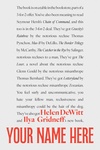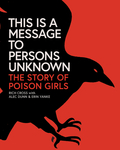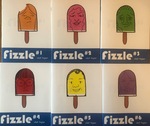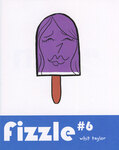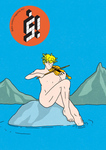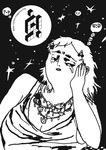
And speaking of important women from the early 20th century whose life and work intersected with early comic books, here's a book that is likely to be the definitive single volume work on Margaret Brundage. Ms. Brundage created a slew of iconic Weird Tales covers during her stint as the magazine's premiere illustrator during the 1930s, such as the 1933 "Bat Girl" that graces this collection's cover. Weird Tales was the horror pulp, providing original publication to the classic works by H.P. Lovecraft, Clark Ashton Smith and Robert E. Howard – among many others – that went on to define contemporary American horror and fantasy; it was in its pages that the genre of Sword and Sorcery was born. The Alluring Art of Margaret Brundage is a revelation in more ways than one. While its sumptuous presentation of what may be the most substantial selection of her classic pulp illustration yet collected is reason enough to celebrate, what makes this book a real standout is its historical and biographical component. Preceding the central art section are a half dozen short essays introducing Brundage, along with a 1973 interview with the artist. Following the art is the book's highlight: "The Secret Life of Margaret Brundage," a heavily illustrated, sixty page essay written by the book's editor, J. David Spurlock which chronicles her fascinating personal life which includes a lengthy involvement with the American political left and the civil rights movement. Who Knew? Now we can all get hep to this fascinating and talented figure.

Here's an up close look at an important publication, focusing on its driving force, Wallace / Wally Wood. Witzend is an intriguing anomaly in comic book history. It was a creator-driven, creator-owned, self-published, independent comics magazine series that began publishing in 1966. And while it was a very forward thinking, new school style of publication in this respect, it was also largely old school in its approach to comics making. Another way of looking at it is that it combines the free spirited approach to comic books that was only barely just getting underway in the world of underground comix (Witzend was published before Zap) and the high degree of professionalism that came with artists with decades of experience in the mainstream comic book industry. It didn't earn Wood the financial returns commensurate with the labor that it required to create, but that didn't stop him from keeping at it. Eight issues were published between 1966 and 1971, and then five more between 1972 and 1985 (the last two posthumously, as Wood died in 1981).
Some of Wood's comics here are over the top in their sexism, and objectification of women, clearly serving his psychological needs to various degrees. So, a certain level of detachment is required to be able to appreciate the artistry and historical significance of the work. By all reports Wood was often difficult and/or unhappy and seems to have perhaps given himself over to comics making to a degree that proved psychologically and emotionally – as well as as financially – unsustainable in the long run. Regardless, he produced a body of work that is widely considered one of the greatest in the storied history of American comic books.
Here's the Publisher, Vanguard's write-up:
Hall of Fame comics creator Wallace Wood's revolutionary, self-published Witzend (often spelled in all lower case) has always been hard to define — the birth of the pro-zine, underground, independent... Whatever you call it, Wood’s Witzend was a mid-'60s milestone event that represented all of the loftiest Fine Art goals of the Underground Movement including art-for-art’s-sake, freedom from censorship, and creator rights. The vast majority of the underground comix movement creators were directly inspired by the EC Comics and Mad work of Wallace Wood and Harvey Kurtzman (as well as psychedelics). Until R. Crumb’s later and eminently notable Zap Comix, no underground had the impact of witzend which combined top-flight comics pros like Wood, Frazetta, Steranko and Ditko side-by-side with up-and-coming Undergrounders like Art Spiegelman (Maus) and Vaughn Bode (Cheech Wizard).
For the first time ever, this single volume collects all of Wood's own contributions to his groundbreaking publication including Animan, Sally Forth, The Rejects, Bucky Ruckus, Pipsqueek Papers, The Wizard King, Snorky, Lunar Tunes, and more. All in glorious black and white like the original magazines but on quality art paper and hardbound to last a lifetime.
We've posted a selection on the Copacetic Tumblr, HERE.

Discovered during move!
ONE slightly dinged (on bottom corners) copy of the oversize – 11" x 15" – full color hardcover collectoin of Frank Frazetta's mosts famous works. Includes roughs, sketches, alternate versions and depictions of the end product (book, magazine, etc.). 112 pages total.
ONE COPY

